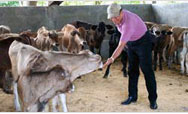Caribbean Regional Program
The Development Challenge: The Caribbean Region consists of 23 relatively small independent islands,
dependent territories, and sovereign states, ranging in size from 91 sq km Anguilla to 214,970 sq km
Guyana. Most share a common history of European colonization and mono-crop plantation economies,
giving rise to a number of developmental similarities and strong correlations among their current
economic problems. Their small size, isolation from markets, susceptibility to natural disasters, and
general ecological vulnerability make the Caribbean a special case for development assistance.
 |
|
Please note: All documents are in pdf format |
During the 1990s, while major preferential trade agreements with former colonial powers still existed, real
GDP in the region grew at an average rate of 3.5%. After the 1990s, this growth rate decreased,
registering 2.5% in 2000, and 1.0% in 2001. From 2002 to the present, some countries in the region are
showing negative real growth. The onset of trade liberalization and globalization has resulted in the
gradual loss of preferential trading agreements which, coupled with the low capital investment, has
caused a reduction in foreign exchange earning potential. The dependence on a very narrow range of
goods and services and limited private sector competitiveness in many of the countries has contributed to
low or negative economic growth.
There has also been inadequate progress in providing the necessary regulatory and institutional
infrastructure to promote private investment. These gaps, combined with the region’s vulnerability to
natural disasters, e.g., floods, hurricanes, and volcanic eruptions, and the global economic downturn post
September 11, have created tremendous developmental challenges for the region. A number of the
Caribbean countries now face growing trade imbalances, unemployment (ranging from 8% in
Antigua/Barbuda to 20% in St Lucia), widening fiscal deficits (from 5.5% of GDP in 2000 to 7.7% of GDP
in 2002/3), and growing unsustainability in their debt stock.
Within this context, critical issues, as seen from the viewpoint of the Caribbean countries and their
regional representative bodies, such as the Caribbean Community Secretariat (CARICOM) and the
Organization of Eastern Caribbean States (OECS), are: (i) the challenge of increasing competition under
the Free Trade Area of the Americas (FTAA), the African Caribbean and Pacific/European Union
(ACP/EU), and the World Trade Organization (WTO) agreements; (ii) the growing threat of HIV/AIDS to
national development (the region’s HIV/AIDS infection rate ranks second in the world); (iii) unemployment
and potential impacts upon safety/security and increased crime; (iv) the need for fiscal reform; (v)
traditional and emerging environmental challenges; and (vi) human capacity deficiencies.
One strategy developed by the CARICOM countries for meeting these growing demands plans for the
formation of a single economic bloc under the Caribbean Single Market and Economy (CSME) by 2005.
At the sub-regional level, the OECS has already created a single monetary and judicial system and has
plans for a more comprehensive economic union within the CSME. Specific implementation deadlines for
both of these parallel efforts, however, have not yet been formalized, and there will be difficulties in
meeting the 2005 deadline. USAID is supporting plans for economic integration as well as other
important initiatives at the regional and sub-regional levels. These include a multi-donor effort to provide
support to the Caribbean Epidemiology Centre (CAREC) to combat HIV/AIDS across the region and to
provide support at the national level. Under CARICOM, a mechanism has been created to assist in
regional trade negotiations to support efforts at both the regional and national levels. At the OECS level,
the Secretariat has created specific organizational units and programs involved in environmental
management, small and medium enterprise development, and trade.
As a third border with the United States, the region’s economic, political and social stability is of critical
importance. The United States considers the small countries of the Caribbean region important partners
on trade, health, education, and homeland security issues.
The USAID Program: USAID provides direct and indirect development support to 23 diverse nations
across the Caribbean region, through a variety of regional institutions, including CARICOM, the OECS,
and the CAREC, among others; however, a large portion of our direct assistance is focused on OECS
member states.
USAID's program focuses on four areas: economic growth and trade, environment, rule of law, and the
fight against HIV/AIDS. The economic growth and trade program is assisting the region with sustainable
economic growth. The program focuses on improving the enabling legislative and regulatory environment
for growth and investment, coupled with firm-level support. A new activity addressing trade and
competitiveness is helping in the transition to new and open trade regimes and the enhancement of
private sector competitiveness. The environment program is based on the recognition that the economies
and the ecosystems of the Caribbean states are inextricably linked. It places emphasis on the tourism
sector in an effort to ensure sustainability of the delicate natural resources upon which this critical industry
depends. It also seeks to promote increased efficiency and competitiveness through improved
environmental management and compliance with internationally accepted standards.
The rule of law program is ensuring that the justice infrastructure is sufficiently modernized to improve
efficiency and applicability of important legal tools for economic growth. USAID assistance is introducing
and improving technology in the judicial system in such areas as case and court reporting. It has also
established a regional legislative drafting facility to draft and revise critical laws for market integration,
security, and HIV/AIDS. The battle against HIV/AIDS is being carried out throughout the wider Caribbean
through a broad-based, multi-donor funded program to enhance capacities for prevention as well as care
and treatment. The program includes elements to support both public and private sector activities in the
region in an effort to strengthen HIV/AIDS non-governmental organizations (NGOs) and NGO networks
and to increase the governments' capacity to fight the spread of the disease. All of these programs have
the active interest and participation of Caribbean governments.
Other Program Elements: The Center of Excellence for Teacher Training (CETT) is a Presidential
Initiative program started in FY 2003, which upgrades the skills of classroom teachers so that they can
become more effective reading instructors. Rural and urban communities, especially those in remote
areas, and schools that have a significant enrollment of Creole-dominant speakers in the Englishspeaking
Caribbean island nations are targeted. The program involves public and private sector
partnerships, and, to date, several U.S.-based companies have supported the program.
A significant portion of the ESF will be transferred to the State Department to address the lack of capacity
many Caribbean nations face in security. Funds ($2,600,000 in FY 2004 and $5,500,000 in FY 2005) will
be used to help Caribbean airports modernize their safety and security regulations and to support border
security programs, including the strengthening of immigration controls.
Other Donors: According to a 2001 World Bank report, the top seven donors to the OECS countries - the
Caribbean Development Bank (CDB), the European Union, the World Bank, UN organizations, Kuwait,
the United States, and Canada (listed by size of contributions) - account for 93% of total disbursements
for 1999-2001. In 2001, the European Union's contribution, which increased to $75 million, was expected
to supercede that of the CDB. For that same period, the largest amount of donor support ($68 million)
was being channeled into the road and transport sector. Education, environment, and budget support
were each allocated another 10% of the total expected disbursements from 1999 to 2001. Education,
health, and social planning together accounted for approximately 17% of the total. CAREC and the
Caribbean Regional Technical Assistance Center (CARTAC) are working in health and finance
respectively and are supported by USAID and several other donors. Donor coordination, however,
remains a challenge in the region given its size and diversity, the number of donors, and the limited
capacity of host governments to participate effectively in projects that are spread across several islands.
This aspect of the regional program is carefully being reviewed with a view to improving the level of
coordination.
Back to Top ^
|


